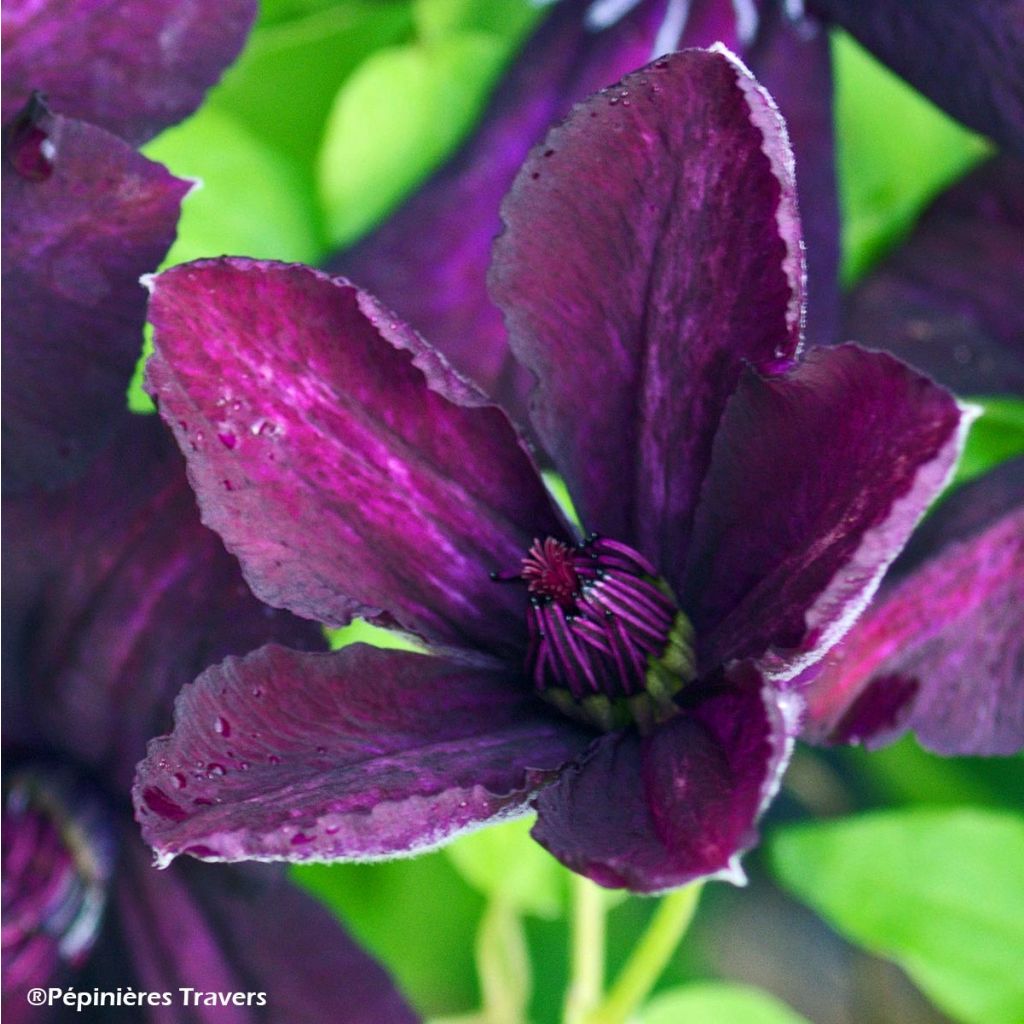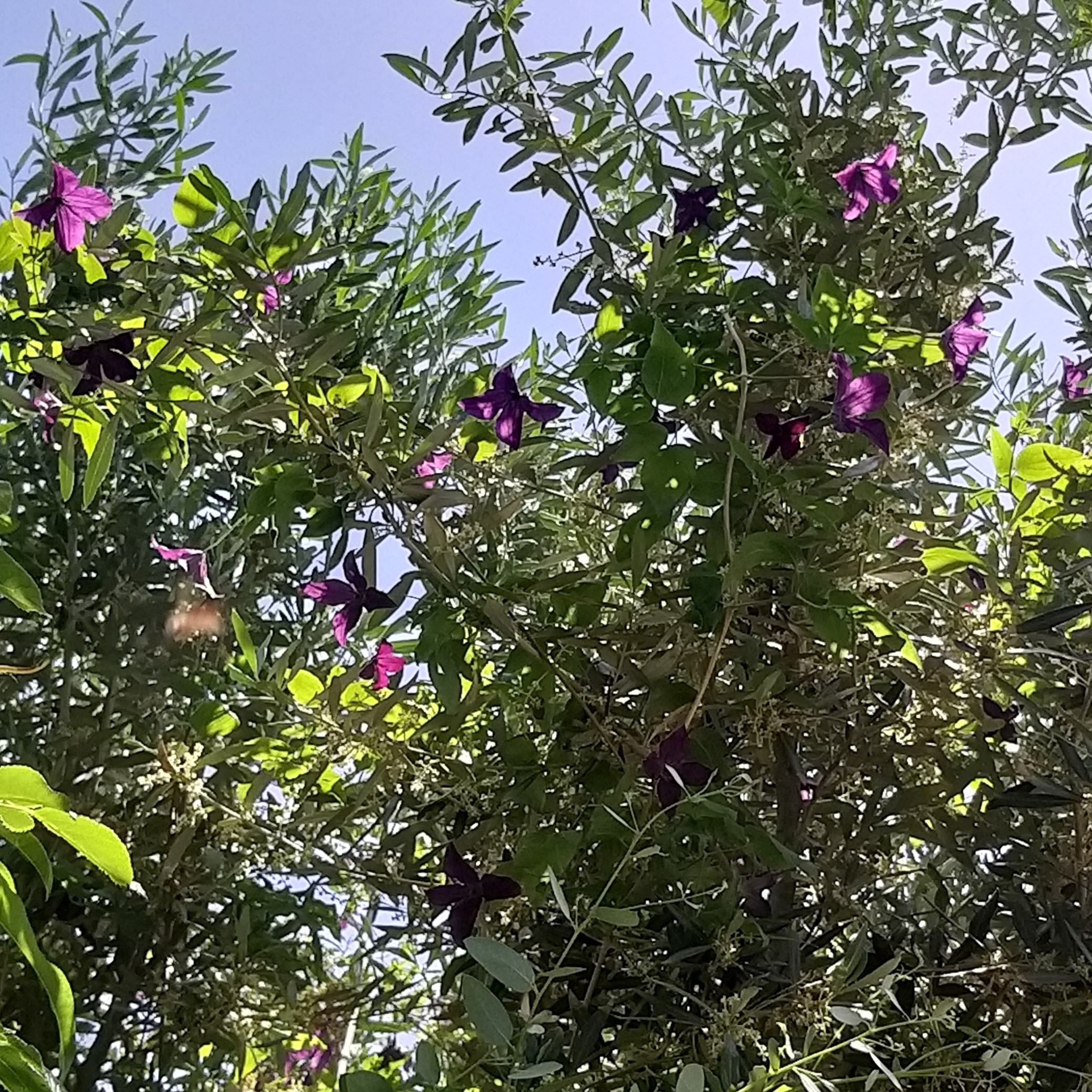

Clematis viticella Dark Eyes


Clematis viticella Dark Eyes
View more pictures
Hide images

Thierry P.

Flowering in May - image 3 - Clematis & Olea Europaea
Thierry P. • 84 FR

Thierry P.

Flowering in May - image 2 - Storming the olive tree.
Thierry P. • 84 FR

Béatrice B.

Gorgeous colours, a marvel...
Béatrice B. • 02 FR
Clematis viticella Dark Eyes
Clematis viticella Dark Eyes
Superb growth. Very satisfied.
Alexandra, 24/10/2025
Special offer!
Receive a €20 voucher for any order over €90 (excluding delivery costs, credit notes, and plastic-free options)!
1- Add your favorite plants to your cart.
2- Once you have reached €90, confirm your order (you can even choose the delivery date!).
3- As soon as your order is shipped, you will receive an email containing your voucher code, valid for 3 months (90 days).
Your voucher is unique and can only be used once, for any order with a minimum value of €20, excluding delivery costs.
Can be combined with other current offers, non-divisible and non-refundable.
Home or relay delivery (depending on size and destination)
Schedule delivery date,
and select date in basket
This plant carries a 6 months recovery warranty
More information
We guarantee the quality of our plants for a full growing cycle, and will replace at our expense any plant that fails to recover under normal climatic and planting conditions.

Would this plant suit my garden?
Set up your Plantfit profile →
Description
Clematis 'Dark Eyes' is as refined and floriferous as its parent, C. viticella. Its small flowers are a rich violet-purple and have dark stamens. This climbing plant blooms from April to October with a first major wave in spring and a less pronounced second bloom from September. This medium-sized clematis is incredibly versatile and can be used to enhance pots and containers in small gardens. It is ideal for dressing up tall spaces, such as small trellises or non-flowering shrubs. Its flowering is sublime in the light or against very light foliage.
The 'Dark Eyes' cultivar is a German creation from 2001 derived from C. viticella, also known as the Italian clematis. It is a deciduous climbing or voluble liana with a woody base, belonging to the Ranunculaceae family. It is characterised by a generous and long summer flowering of small single flowers with 4 white, blue, or pink petals. The compound leaves consist of 5 to 7 entire leaflets of a beautiful vibrant green. They are carried by voluble petioles called tendrils that wrap around their support. Like most of its cousins, it prefers light, moist and fertile soil that is preferably neutral. It appreciates a sunny or partially shaded exposure, with its base always shaded. This hardy climber withstands cold and does not fear frost. However, it does not like stagnant moisture, so the substrate must be well-draining and watering should be moderate (if necessary, in the first year). It is suitable for container cultivation if the container is large enough (minimum 60cm (24in) in diameter).
Clematis 'Dark Eyes' can reach up to 3m (10ft) in height and 1m (3ft) in width. It belongs to group 3, which includes species with late-flowering on new growth. This group includes large-flowered climbing clematis blooming from July to September, small-flowered climbing clematis blooming between June and October, and herbaceous non-climbing clematis bearing flowers between July and October. 'Dark Eyes' belongs to the category of small-flowered clematis, along with other Italian clematis. Its single star-shaped flowers consist of 4 petals, 5 to 8cm (2 to 3in) in diameter. They are narrowly elliptical, acuminate, slightly recurved at the edges and tips, and overlapping at their base. The variety has a cluster of short, closely spaced stamens at its centre, which are not very noticeable as they are the same dark colour. They take on a more decorative silvery hue that contrasts with the petals. Dry fruits with feathery aigrettes appear later. They decorate the foliage until winter.
Clematis benefits from the proximity of other plants that drain the soil while protecting its base from drying out. Plant spring bulbs and a few ground-cover perennials such as geraniums or dead nettles at its base and enjoy the show with minimal maintenance. If you have a larger space, this clematis will climb over shrubs or a column and bring verticality to colourful flower beds. Climbing clematis are also the best companions for roses. The intensity of 'Dark Eyes' flowers will stand out better in the light or against the golden foliage of Mexican Orange Blossom 'Goldfinger'.
Report an error about the product description
Clematis viticella Dark Eyes in pictures




Plant habit
Flowering
Foliage
Botanical data
Clematis
viticella
Dark Eyes
Ranunculaceae
Cultivar or hybrid
Other Clematis Viticella
View all →Planting and care
Plant in spring or autumn. It prefers moist soils that are not waterlogged, deep, well-worked, drained, and rich. Plant at a depth of 5cm (2in), with the root ball placed diagonally or even lying on the soil. Position the clematis with its head in the sun (or partial shade) and its base in the shade. You can place a flat tile in front of the stump or use ground cover plants to provide the necessary shade. Cover the foot with a small mound of soil to encourage new shoots. After planting, cut back the stems to 30cm (12in) from the base, above a pair of buds.
Train the clematis loosely to help the plant cling on its own.
Planting period
Intended location
Care
-
, onOrder confirmed
Reply from on Promesse de fleurs
Similar products
Haven't found what you were looking for?
Hardiness is the lowest winter temperature a plant can endure without suffering serious damage or even dying. However, hardiness is affected by location (a sheltered area, such as a patio), protection (winter cover) and soil type (hardiness is improved by well-drained soil).

Photo Sharing Terms & Conditions
In order to encourage gardeners to interact and share their experiences, Promesse de fleurs offers various media enabling content to be uploaded onto its Site - in particular via the ‘Photo sharing’ module.
The User agrees to refrain from:
- Posting any content that is illegal, prejudicial, insulting, racist, inciteful to hatred, revisionist, contrary to public decency, that infringes on privacy or on the privacy rights of third parties, in particular the publicity rights of persons and goods, intellectual property rights, or the right to privacy.
- Submitting content on behalf of a third party;
- Impersonate the identity of a third party and/or publish any personal information about a third party;
In general, the User undertakes to refrain from any unethical behaviour.
All Content (in particular text, comments, files, images, photos, videos, creative works, etc.), which may be subject to property or intellectual property rights, image or other private rights, shall remain the property of the User, subject to the limited rights granted by the terms of the licence granted by Promesse de fleurs as stated below. Users are at liberty to publish or not to publish such Content on the Site, notably via the ‘Photo Sharing’ facility, and accept that this Content shall be made public and freely accessible, notably on the Internet.
Users further acknowledge, undertake to have ,and guarantee that they hold all necessary rights and permissions to publish such material on the Site, in particular with regard to the legislation in force pertaining to any privacy, property, intellectual property, image, or contractual rights, or rights of any other nature. By publishing such Content on the Site, Users acknowledge accepting full liability as publishers of the Content within the meaning of the law, and grant Promesse de fleurs, free of charge, an inclusive, worldwide licence for the said Content for the entire duration of its publication, including all reproduction, representation, up/downloading, displaying, performing, transmission, and storage rights.
Users also grant permission for their name to be linked to the Content and accept that this link may not always be made available.
By engaging in posting material, Users consent to their Content becoming automatically accessible on the Internet, in particular on other sites and/or blogs and/or web pages of the Promesse de fleurs site, including in particular social pages and the Promesse de fleurs catalogue.
Users may secure the removal of entrusted content free of charge by issuing a simple request via our contact form.
The flowering period indicated on our website applies to countries and regions located in USDA zone 8 (France, the United Kingdom, Ireland, the Netherlands, etc.)
It will vary according to where you live:
- In zones 9 to 10 (Italy, Spain, Greece, etc.), flowering will occur about 2 to 4 weeks earlier.
- In zones 6 to 7 (Germany, Poland, Slovenia, and lower mountainous regions), flowering will be delayed by 2 to 3 weeks.
- In zone 5 (Central Europe, Scandinavia), blooming will be delayed by 3 to 5 weeks.
In temperate climates, pruning of spring-flowering shrubs (forsythia, spireas, etc.) should be done just after flowering.
Pruning of summer-flowering shrubs (Indian Lilac, Perovskia, etc.) can be done in winter or spring.
In cold regions as well as with frost-sensitive plants, avoid pruning too early when severe frosts may still occur.
The planting period indicated on our website applies to countries and regions located in USDA zone 8 (France, United Kingdom, Ireland, Netherlands).
It will vary according to where you live:
- In Mediterranean zones (Marseille, Madrid, Milan, etc.), autumn and winter are the best planting periods.
- In continental zones (Strasbourg, Munich, Vienna, etc.), delay planting by 2 to 3 weeks in spring and bring it forward by 2 to 4 weeks in autumn.
- In mountainous regions (the Alps, Pyrenees, Carpathians, etc.), it is best to plant in late spring (May-June) or late summer (August-September).
The harvesting period indicated on our website applies to countries and regions in USDA zone 8 (France, England, Ireland, the Netherlands).
In colder areas (Scandinavia, Poland, Austria...) fruit and vegetable harvests are likely to be delayed by 3-4 weeks.
In warmer areas (Italy, Spain, Greece, etc.), harvesting will probably take place earlier, depending on weather conditions.
The sowing periods indicated on our website apply to countries and regions within USDA Zone 8 (France, UK, Ireland, Netherlands).
In colder areas (Scandinavia, Poland, Austria...), delay any outdoor sowing by 3-4 weeks, or sow under glass.
In warmer climes (Italy, Spain, Greece, etc.), bring outdoor sowing forward by a few weeks.


















































